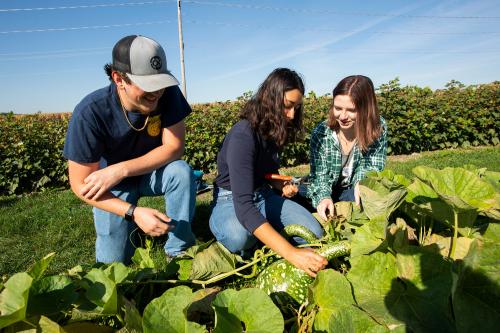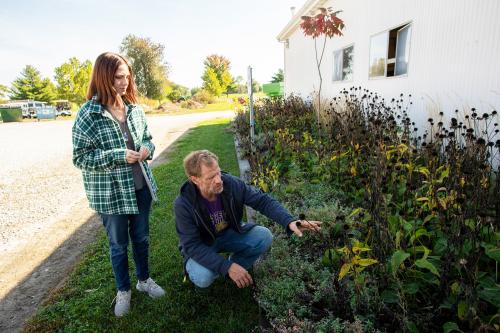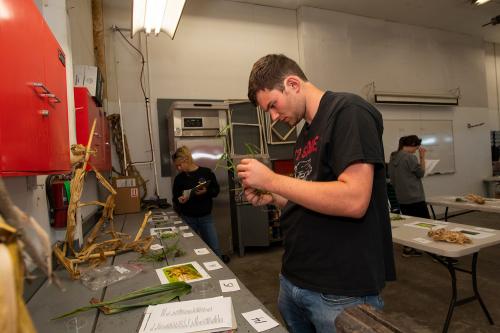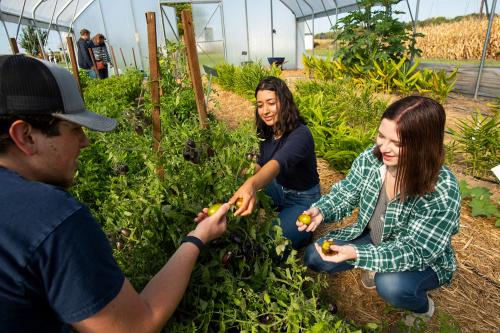University News
Teaching Garden Brings WIU School of Agriculture Lessons to Life
October 31, 2022
MACOMB, IL – While it's not unusual to drive by a farm this time of year and see pumpkins and gourds peeking out of the fields, at Western Illinois University it's a hint the School of Agriculture is using one area of the Agricultural Field Laboratory's Agronomy Farm as an outdoor classroom and laboratory.
The Plant Sciences Teaching Garden was developed by WIU Professor Mark Bernards and Assistant Professor Shelby Henning to provide hands-on activities and learning for their Agronomy and Horticulture classes. Plantings include a wide variety of field crops like cotton, sorghum and tobacco, numerous vegetables, flowers, herbs and even an extensive collection of weeds, which are planted within plastic drainage tubing.
The Plant Sciences Teaching Garden has been in place for about 10 years.
Henning said the garden is a hands-on way to introduce students to common crop and weed species, but also expose them to crops grown globally that they might not expect to find growing in Illinois.
"It's one thing to see these plants and weeds in pictures, or in a Power Point," said Henning. "But our goal is to show students more than corn and soybeans growing in the field. We want students to experience the diversity of agriculture. In terms of teaching, it's gold – during my undergraduate days I wish I would have had something like this to learn with."
In addition to teaching students how to identify numerous plant species, the garden is also used to teach about plant biology and the diseases, weeds and insects that can negatively affect crops.
"The initial goal was to have a place where we could always have hands-on lab activities," said Bernards. "We start by teaching plant morphology, so students can learn to identify plants, then how to classify plants by family and use, and, later to introduce insect, disease and weed management. One of the highlights for me is the weed garden, where we have about 120 weed species growing throughout the year, which are used in several classes."
Henning said the irony of having to pull weeds from the garden is not lost on him.
"We have to weed the weed garden all the time," he said. "In addition, I also have a weakness for planting weird stuff; things that don't always look beautiful, but that have fascinating traits that show the amazing diversity in nature. Working with and observing the weeds in the garden has forced me to reevaluate my previous opinion that these species had no redeeming qualities. I have unexpectedly become fond of and respectful of many weeds."
WIU Agricultural Science major Claudia Duarte, a senior from Chicago, is a student research assistant who tends to the outdoor laboratory spaces. She has also spent class time in the gardens.
"I am fascinated in learning about all of the different plants, how to grow them property, identifying particular pests that impact them and especially being able to handle them in person; it's been a great learning tool," she said.
Because of the weather patterns in Illinois, the field laboratory is mostly used during three seasons of the year. The balance of the time, students enjoy lab activities in the School of Agriculture greenhouses. A high tunnel at the Agronomy Farm, which extends the growing season for research plantings, is also a learning area for students. Plantings in the high tunnel include a wide variety of plant species, such as tomatoes, peppers, beans, ginger, turmeric and hemp.
A new learning space was added at the University's Livestock Center, adjacent to the greenhouse. Stephanie Miller, a School of Agriculture alumna, designed the Sustainable Landscapes Teaching Garden as a class project.
Henning said the intention of the teaching garden was to demonstrate that landscaping can be both visually appealing and environmentally conscious.
"The garden provides long-term environmental benefits in many ways," he said. "For example, the planting does not require supplemental irrigation or fertilizer, and it increases species diversity in the area by including both ornamental and native plants in the design. The garden is filled with many different species, and is a pollinator paradise during the entire growing season."
Henning added that each spring a bonanza of blooming bulbs showers visitors with beauty. After the daffodils and hyacinths have faded, a variety of wildflowers, intentionally chosen to provide consistent blooms over the coming months, begin a succession of flowers to support pollinators over the entire growing season. Even in the deepest part of winter, the seedheads left standing long after flowers have faded provide food for goldfinches and other birds to eat over the winter months.
In Spring 2023, WIU's Horticulture Club, led by President Mackenzie Kolodziejski, a junior agriculture education major from Cuba, IL, will choose the additional plant species to add to the space. Club members installed a few plantings last year, and Kolodziejski said she and club members will collaborate on what species should be added.
Henning added some decorative corn to the site as a nod to its importance to the curriculum.
"There is overlap between agronomic and horticulture disciplines," said Henning. "The division isn't as clear cut as some might think. Many crop plants have been bred for aesthetics and food production so they fit into both categories."
For more information on the variety of academic programming offered in WIU's School of Agriculture, visit wiu.edu/agriculture.
Posted By: Jodi Pospeschil (JK-Pospeschil@wiu.edu)
Office of University Communications & Marketing





Connect with us: